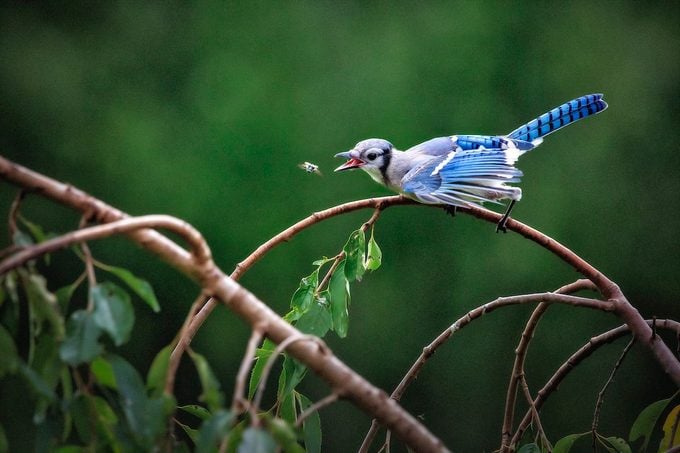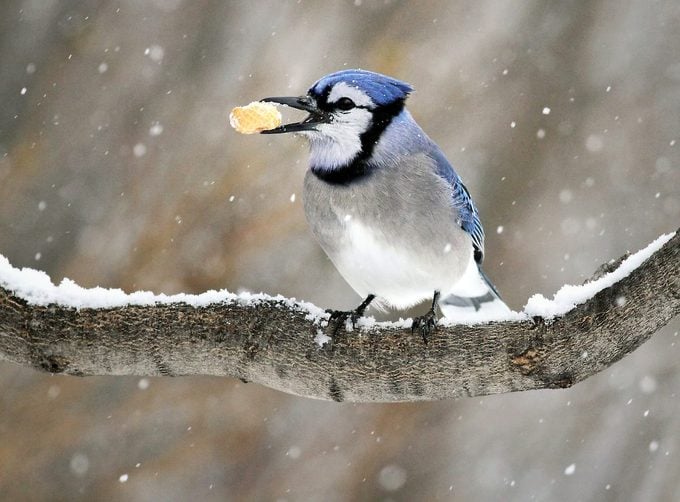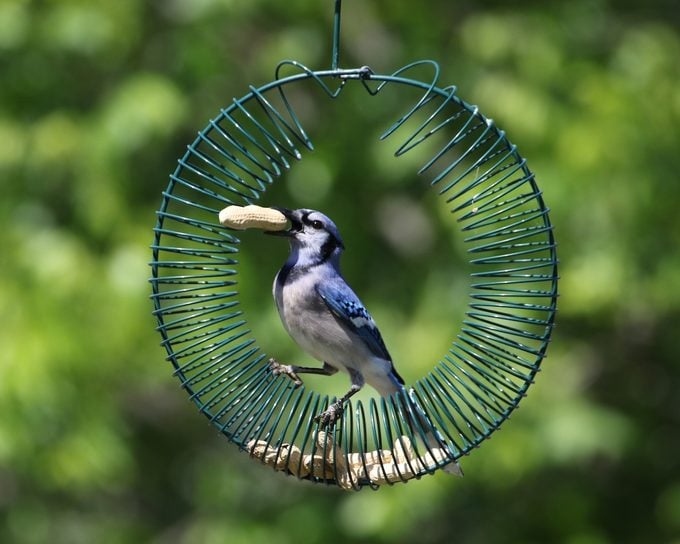What Foods Do Blue Jays Eat?
Updated: Dec. 18, 2023
If you want to feed these bold birds in your backyard, you need to know what blue jays eat. Experts reveal the best foods to attract blue jays.
On This Page
Do Blue Jays Eat Insects?

“I saw a blue jay flying up to the eaves of my house and then down to the roof. It was dissecting a wasps’ or bees’ nest. Do blue jays eat those insects?” asks Melody VanOteghem Milan, Illinois.
Birding experts Kenn and Kimberly Kaufman say, “Blue jays are fun to watch. These large, blue colored birds are clever and adaptable with a varied diet.
In addition to nuts and seeds, blue jays may eat other food sources such as berries, bugs and frogs. They usually don’t eat adult bees or wasps, but sometimes they will break open a wasps’ nest to eat the soft larvae inside. Around a small wasps’ nest, blue jays have been observed catching and crushing the adult wasps and dropping them on the ground. Then, with the stinging adults out of the way, the jays will break off pieces of the nest to eat the young wasps inside it.”
Here’s why the blue jay’s range is expanding westward.
“Blue jays prefer to eat their food from tray and hopper feeders, or another flat raised surface. Their robust bill can make quick work of peanuts, acorns, sunflower seeds and even suet. We often joke that these smart birds seem to have what we call “peanut radar.” We can go for days without seeing any blue jays, but the minute we put out the peanuts, they quickly appear. Peanuts not only provide protein for birds, they’re also a good source of unsaturated fat,” Kenn and Kimberly explain.
Meet 8 types of jays you should know.
Blue Jays Crack Open Nuts

“How do blue jays know to crack open peanut shells to get the nut inside?” asks reader Dennis Hockensmith of Boonsboro, Maryland.
Kenn and Kimberly say, “Blue jays are intelligent and adaptable, with omnivorous tastes. Acorns, hazelnuts, hickory and other wild nuts can provide 40% or more of their diet. To break these open, jays hold them against a perch with one foot and hammer on them with their beaks.
Peanuts are not native to North America (and technically they’re classified as legumes), but they’re somewhat similar to native nuts, and curious blue jays will experiment and learn to crack them open. They also learn by watching each other, so if one jay has figured out the peanuts, others will quickly follow their example.”
Don’t miss these beautiful blue jay photos.
Do Blue Jays Cache Food?

The blue jay has an expandable throat pouch where it can temporarily store peanuts or acorns. These birds also cache seeds and nuts by shoving them into the soil, to retrieve later. Uneaten caches sprout into new oaks, walnuts, pines, and other trees, to keep forests renewed…or to tickle us with an unexpected cluster of sunflower seedlings!
“The blue jays that visit our feeders are difficult to photograph. They’re very skittish, darting in to snatch a peanut and then quickly flying away to either enjoy it or stash it for later. Oftentimes, the greedy jays store one peanut in their craw before plucking a second one and flying away,” says Linda Taylor of Waco, Texas.
Next, learn how to tell the difference between bluebirds vs blue jays.




















